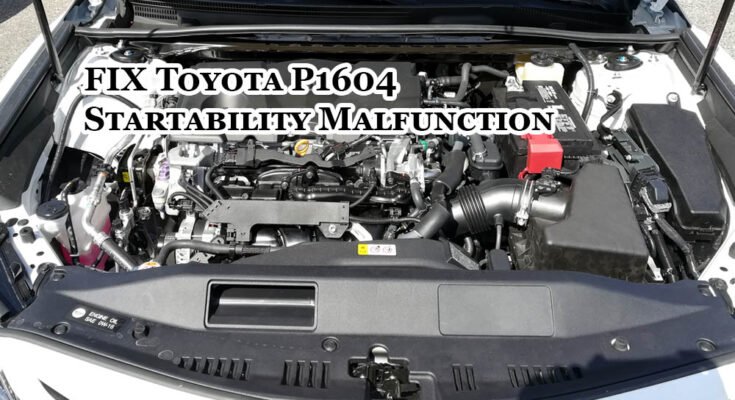The P1604 code in a Toyota, which relates to a startability malfunction, can be triggered by various issues that affect the engine’s ability to start properly. Here are the key reasons for this error:
Battery-Related Issues
- Low Battery Voltage: If the battery is low on charge, it may not supply enough power to start the engine.
- Weak or Failing Battery: An old or deteriorating battery may have insufficient cranking power.
- Loose or Corroded Battery Terminals: Poor connections at the battery can reduce the power flow, affecting starting performance.
Starter Motor Problems
- Faulty Starter Motor: A defective starter motor may struggle to turn the engine over or may fail completely.
- Starter Solenoid Issues: Problems with the solenoid that engages the starter can prevent the engine from turning over.
Fuel Delivery Issues
- Fuel Pump Malfunction: A failing fuel pump may not deliver adequate fuel pressure, leading to starting difficulties.
- Clogged Fuel Filter: A blocked fuel filter can restrict the flow of fuel to the engine, making it hard to start.
- Faulty Fuel Injectors: Injectors that are clogged or not functioning properly can prevent the right amount of fuel from reaching the combustion chambers.
Ignition System Issues
- Worn Spark Plugs: Old or fouled spark plugs can lead to misfires, making it difficult for the engine to start.
- Ignition Coil Problems: A failing ignition coil can prevent spark generation, causing starting issues.
Engine Control Module (ECM) or Powertrain Control Module (PCM) Problems
- Faulty ECM/PCM: A malfunctioning ECM/PCM may not properly control the starting sequence, which could trigger the P1604 code.
- Software or Calibration Issues: In some cases, a software update or ECM reprogramming might be necessary if the problem stems from incorrect calibration.
Mechanical Issues
- Low Engine Compression: If the engine’s compression is low due to wear or internal damage, it might struggle to start.
- Timing Chain/Belt Problems: A worn or misaligned timing chain or belt can cause the engine timing to be off, affecting startability.
Wiring and Connections
- Loose or Damaged Wires: Wiring issues between the starter, battery, ECM, or other related components can cause voltage drops, impacting the starting system.
- Poor Ground Connections: A weak ground connection can affect the electrical circuits involved in starting the engine.
Environmental Factors
- Extreme Temperatures: Very cold or hot weather can put additional strain on the battery and starter system, sometimes leading to starting issues.
Addressing the specific cause of the P1604 code will require a step-by-step diagnosis of these potential areas. It’s advisable to start with the most common and straightforward checks, such as the battery and starter system, and then proceed to more complex components if the issue persists.
How to Fix P1604
To fix the P1604 code (Startability Malfunction) in your Toyota, you can follow these steps for a systematic diagnosis and repair process:
Check and Charge the Battery
- Inspect the Battery Terminals: Ensure the terminals are clean and free from corrosion. Tighten any loose connections.
- Test Battery Voltage: Use a multimeter to check the battery voltage. A fully charged battery should read around 12.6 volts. If it’s significantly lower, charge or replace the battery.
- Load Test the Battery: If the battery is older, a load test can determine if it holds a charge properly.
Inspect the Starter Motor and Solenoid
- Listen for Noises: If the engine clicks but doesn’t start, the starter motor might be faulty.
- Check for Power at the Starter: Use a test light or multimeter to verify that the starter is receiving power when the key is turned to the start position. If not, there may be an issue with the ignition switch or wiring.
- Replace the Starter: If the starter motor is determined to be faulty, replace it.
Evaluate the Fuel System
- Check Fuel Pump Operation: Listen for the fuel pump’s hum when turning the ignition key to the “on” position. If you don’t hear it, check the fuel pump relay, fuse, and the pump itself.
- Test Fuel Pressure: Use a fuel pressure gauge to ensure the fuel pressure meets the manufacturer’s specifications. Low pressure might indicate a failing pump or clogged filter.
- Inspect Fuel Injectors: Use a scan tool to perform an injector balance test or visually inspect injectors for leaks.
Inspect the Ignition System
- Check Spark Plugs: Remove a spark plug and inspect its condition. Replace worn, fouled, or damaged plugs.
- Test Ignition Coils: Use an ohmmeter to test the coils for proper resistance. Replace any coils that are out of spec.
- Inspect Coil Wiring: Ensure there are no breaks or corrosion in the wiring to the ignition coils.
Examine the ECM/PCM
- Reset the ECM: Use an OBD-II scanner to clear the P1604 code and see if it returns. This can help determine if the problem is persistent or was a temporary issue.
- Check for Software Updates: Some startability issues can be resolved with ECM reprogramming or a software update. Contact a Toyota dealership for any known recalls or updates for your vehicle.
Inspect Wiring and Connections
- Check Ground Connections: Ensure that all ground connections between the engine, body, and battery are secure and free from corrosion.
- Inspect Wiring Harnesses: Look for any damaged, pinched, or disconnected wires, especially around the starter and fuel systems.
Address Mechanical Issues
- Check Engine Compression: If other steps don’t solve the problem, perform a compression test to verify the engine’s health. Low compression may require further diagnosis of the valve train or piston rings.
- Inspect Timing Components: If the engine is cranking but not starting, inspect the timing belt or chain for wear or misalignment, as this can throw off the engine timing.
Consult a Professional if Needed
- If the above steps don’t resolve the issue or you’re unsure about performing any of these steps, it’s wise to consult a certified mechanic. They can use more advanced diagnostic tools to pinpoint the exact cause of the P1604 code.
Final Step: Clearing the Code
- After repairs, use an OBD-II scanner to clear the code. Drive the vehicle for a short distance to see if the code returns. If it doesn’t, the issue is likely resolved.
By following this approach, you can systematically identify and address the causes behind the P1604 error code
How to Reset the Code
To reset the P1604 code on a Toyota after addressing the underlying issues, you can follow these steps. It’s important to ensure that the problem is fixed before resetting the code to prevent it from reappearing:
Method 1: Using an OBD-II Scanner
The most effective way to reset a trouble code like P1604 is by using an OBD-II scanner. Here’s how to do it:
Connect the OBD-II Scanner:
- Locate the OBD-II port under the dashboard on the driver’s side (usually near the steering column).
- Plug the OBD-II scanner into the port.
Turn the Ignition to the “ON” Position (but do not start the engine):
- This will power up the scanner and the car’s computer.
- Wait for the scanner to establish a connection with the vehicle’s computer.
Read the Diagnostic Trouble Codes (DTCs):
- Follow the prompts on your scanner to read the current trouble codes.
- Confirm that P1604 is one of the codes displayed.
Select the “Erase” or “Clear Codes” Option:
- Use the scanner to clear the codes. The exact process depends on the make of your scanner, but it usually involves selecting an option like “Erase Codes” or “Clear DTCs.”
Turn Off the Ignition and Disconnect the Scanner:
- Turn off the ignition and unplug the scanner.
- Start the car to see if the Check Engine Light stays off.
Test Drive the Vehicle:
- Drive the vehicle for a short distance to see if the P1604 code returns. If it does not come back, the reset was successful.
Method 2: Disconnect the Battery (Manual Reset)
If you don’t have an OBD-II scanner, you can try resetting the code manually by disconnecting the battery. However, this method might not always be as effective and can reset other settings like the radio and clock:
Turn Off the Ignition:
- Make sure the car is off before proceeding.
Disconnect the Negative Battery Terminal:
- Use a wrench to loosen the nut on the negative (-) terminal of the battery and remove the cable.
- Leave the cable disconnected for about 10-15 minutes. This allows any residual power to drain from the car’s computer.
Reconnect the Battery:
- Reconnect the negative battery terminal and tighten the nut securely.
Start the Car:
- Turn on the ignition and start the vehicle to see if the Check Engine Light has turned off.
Drive the Vehicle:
- Similar to the scanner method, take the vehicle for a short drive to ensure that the issue has been resolved and the light remains off.
Method 3: Visit a Mechanic or Dealership
- If you’re not comfortable using an OBD-II scanner or if the manual reset doesn’t work, you can visit a professional mechanic or a Toyota dealership.
- They can perform a more comprehensive scan and reset the code using professional diagnostic tools.
Important Note:
- If the code returns shortly after resetting it, it means that the underlying issue has not been fully resolved. Make sure to recheck the common causes like the battery, starter, fuel system, or any wiring issues related to the P1604 code before attempting another reset.




